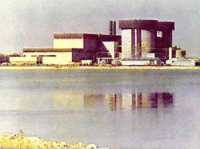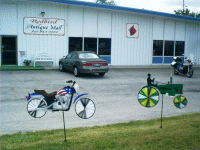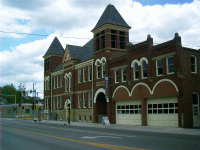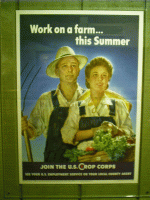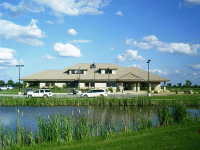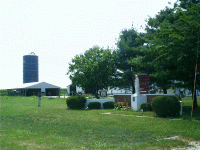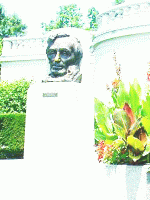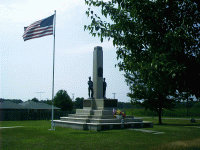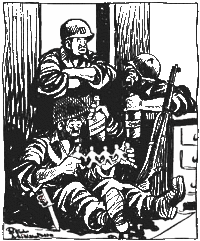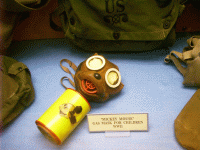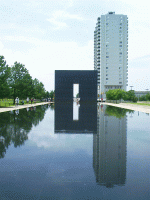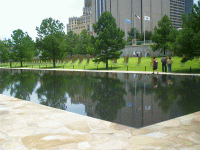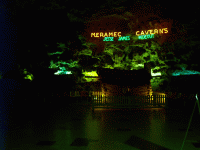 |
Meramec Caverns
I've been in other caves. I've been in other "show caves." This was the nicest in
terms of tourist comfort.
First of all, it doesn't smell like a cave. They have some
superduper citrusy substance that they must spritz into the air or
slather on the guide rails or something. You just can't believe
you're in a dank underground chamber. It never occurs to you that
you are cheek by jowl next to a bunch of other sweaty tourists.
Under the neon sign, which tells
you where you are, there is a replica moonshiner's shack complete with
still. The tour guide frankly confesses this has nothing to do with the
history of Meramec Caverns ~ political, social, or geologic ~ but is
merely included as an Ozarks reference ~ so you know where
you are.
Likewise there is a Jesse James diorama.
|
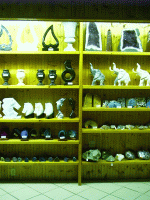 |
Gift Shop, Meramec Caverns
You have to walk past the cafeteria to get to the gift shop, which
entirely encloses the mouth of the cave. In the old days, people
would drive into the cave and dance on a grandstand built inside.
Contemporary visitors may be forgiven for assuming that cave floors are
typically flat enough not only to dance on but also to lay a tile floor
on.
|
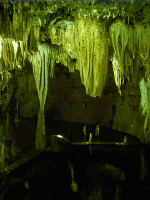 |
Meramec Caverns
There is an illuminated picture portrait of Lassie in the cave because
an episode of the ever-popular TV series (starring Opie Taylor) was
filmed here. You remember it, I'm sure. It's the one where
Lassie rescues Timmy, or was it Flipper?
Art Linkletter did a gag for his TV show in which a pair of contestants
personated a prehistoric cave couple, performing a skit for the
amusement of tourists. This is remembered with
fondness and
commemorated, too, with a stop on the tour and concomitant signage.
There is even a Foucault pendulum installed in the cave for a local
science fair. It is one of only 16 in the known world. It
is the only one that doesn't work. It's too lightweight. It
doesn't store enough energy to keep going long enough for the
precession of the earth to be obvious. |
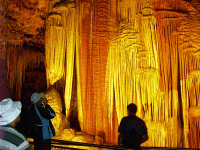 |
Meramec Caverns
By now in my description, I've given you the idea that the Meramec
Cavern tour is about anything other than the cave. This is not
true. There's plenty of cave stuff in the cave and a river, too; you
just have to walk for a way to get to it. Also, you have to climb
stairs ~ one whole flight ~ so I ask you: If you were a guide in charge
of a bunch of sweaty tourists, what would you talk about?
The finale is a light show in a "room" with a curtain wall of flowstone
(and theater seating). This is accompanied by a recording of Kate
Smith (1907-1986) singing Irving Berlin's God Bless America.
Apparently hers is the only performance that could ever shake loose a
cascade of
water from the flowstone. Kate Smith fans don't seem to feel that
this is any kind of
exploitation.
|
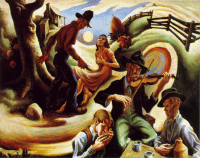
[Benton, Thomas Hart. The Ballad of the Jealous
Lover of
Lone Green Valley. 1934. Spencer Museum of Art, University of
Kansas, Lawrence.]
|
Okie Baroque
I want to include an image not relevant to Old US Route 66 except for
its Ozark connection and because its artist was a native of Missouri.
This Regionalist masterpiece by Thomas
Hart Benton (1889-1975) includes a haystack, a cow, and an
outhouse. It is a representation of an Ozark folk song, The Jealous
Lover, but I doubt that the traditional lyrics refer to these
extraneous elements. Okie Baroque is a term of derision applied
to
Regionalism in art, notwithstanding that the subject matter and the
artist, too, generally operate at some distance from Oklahoma.
OK, how does the painting make you feel? Dizzy? To me, it's "merely
humorous."
Obviously, the musicians in the scene conjure the scene, so we have
to account for recursion in the composition. El Greco
distortion allows some dramatic distance from the action; there's no
transubstantiation expected; the painting merely epitomizes country
music or the act of
making it, anyway. The characters are paired. The intensity of the
villain is mirrored in the harmonica player. The singer expresses the
heroine's expression. All is done in the deadpan style traditional to
folk-music performance. The performers distort a facsimile of reality
without expecting to be caught in it. They depend on their audience
to differentiate between story built of substance and reality from
which substance is borrowed.
Benton's figures are foreshortened as though you were to view them from
below. To keep them from looming out of the frame, he uniformly
positions the foreground behind a sill that the viewer must strain to
see over.
Note: The harmonica player is assumed to be Jackson Pollock.
Discussion question: What is the mood of the cow?
|
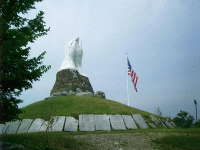 |
Statue (1972), Praying Hands by Jack Dawson, Webb City, MO
- American flags
flapped in the breeze Thursday at King Jack Park as
about four dozen people clasped hands in circles of prayer.
- They prayed for
unity. They prayed for guidance for national and local
governmental leaders. And, they prayed for continued religious freedom
and Christian reform.
- Similar prayers
echoed throughout area towns at breakfast meetings and
ceremonies in observance of the National Day of Prayer. This is the
54th year that the observance, established by an act of Congress, has
folded the hands of participants on the first Thursday in May.
- "I'm all for this
program," said Betty Lamb, of Webb City. "I think
it's needful. I think unless we turn and hold up prayer before the
Lord, our nation is in peril."
- Webb Citians have
an appropriate site for the ceremony: at the foot of
a hill where the Praying Hands statue was erected 34 years ago. The
creator of the sculpture, Jack Dawson, and his wife, Nancy, were
speakers at Thursday's event.
- "It's not a political statement but a spiritual one,"
Dawson said of the statue. He said the folded hands that stand along
Missouri Highway 171 represent a silent reminder every day that
"humility before a living God is where we find that spiritual peace."
- The United States was founded on a number of precepts that
include the right to religious freedom. The Founding Fathers relied on
Christianity to underpin the nation they created, Dawson said. He
quoted George Washington as having said, "It is impossible to rightly
govern the world without God and the Bible."
[Woodin, Debby. "'One
Nation Under God': Area Christians Pray for Nation as Part of
Observance." Joplin Globe n. seq. (6 May 2005): 9 pars. Online.
Internet. 16 Aug. 2005. Available http://www.joplinglobe.com/siteSearch/
apstorysection/local_story_098104212.]
|
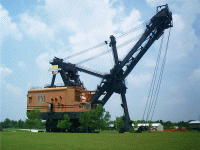 |
Big Brutus, West Mineral, KS
In the southeast corner of Kansas, stands this remnant of strip mining
for coal. This shovel was parked on the verge of its last dig and
decommissioned in 1974 after running day and night for eleven years.
Its motors and hydraulic pumps were removed. In 1985, stairways were
installed for tourist
access. Because of insurance-company concerns, patrons are no
longer permitted on the boom.
The model 1850-B, built by Bucyrus-Erie, is still the second largest
electric shovel in the world. It ran off the end
of a giant extension cord. Its final monthly electric bill was $27
thousand.
[Big Brutus: Explore it! West Mineral, KS: Big Brutus, Inc.,
n.d.]
|
 |
Mining Promo Patches, West Mineral, KS
|
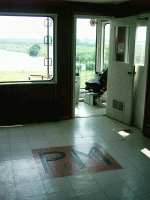 |
Operator's Cabin, Big Brutus, West Mineral, KS
The operator's cab was the nerve center of the shovel. The
breakroom and operator's cab were air conditioned. The monogram
worked in the linoleum tile stands for Pittsburg and Midway Coal Mining
Company. P&M paid $6.5
million for Big Brutus in 1962.
|
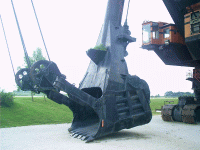 |
Bucket, Big Brutus, West Mineral, KS
The
shovel required a running crew of only three: operator, oiler, and
groundman. It was
used to remove overburden from coal seams.
The operator's cab projects from the
corner of the house.
The bucket held 135 tons or more. There are stunt pictures of workers'
parking
a pickup inside. |
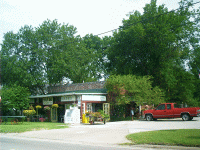 |
Eisler Market (1925), Riverton, KS
- The store was
built in 1925. It was originally a Standard Station. By 1932, a Y Not
Eat Barbecue had been added. The Eisler family bought the location in
1973 and opened a market and deli. The old building is well maintained
and still contains the original pressed tin ceiling.
["Riverton." Kansas Route 66
Association n. seq. (28 June 2005): 7 pars. Online. Internet. 17
Aug. 2005. Available http://ksrt66association.prnservices.net/
Riverton.html.]
|
 |
Eisler Market, Riverton, KS
Stop here for all your Route 66 needs. Many travelers find the porch a
convenient and pleasant place to hog down a sandwich and soft drink. |
 |
Heyburn Lake, Kellyville, OK
- Heyburn Lake was
named after the community of Heyburn, a post office
from 1911-1922, located near the place where the St. Louis-San
Francisco Railroad crossed Polecat Creek. The project is located on
Creek lands in the former Indian Territory. Many of the towns
surrounding the project began as trading posts and developed as
settlements as the railroads moved west.
[United States. Army.
Corps
of Engineers. "Heyburn Lake Oklahoma." Corps Lakes Gateway n.
seq. (n.d.): 11 pars. Online. Internet. 17 Aug. 2005. Available http://corpslakes.usace.army.mil/
visitors/visitors.cfm.]
|
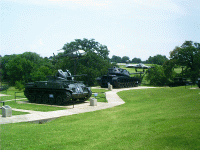 |
45th Infantry Division Museum
If you are into ordnance, be sure to visit the 45th Infantry
Division Museum in Oklahoma City, OK. Outdoors, there's a pasture
with lots of tanks, cannon, and aircraft. Indoors, there are guns,
guns,
and more guns. The history of firearms in warfare is pretty well
covered with not one but several examples from every major conflict.
Annotated displays compare and contrast the various specimens.
|
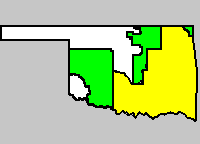
["Tribes and Nations of Oklahoma and Indian
Territories." OKGenWeb n. seq. (6 June 2003): n. pag. Online.
Internet. 18 Aug. 2005. Available http://www.rootsweb.com/
~okgenweb/maps/itmap.htm.]
|
Tribes and Nations of Oklahoma and Indian Territories
Several exhibits at the 45th Infantry Division Museum deal with Indian
Wars. One includes a map like this, showing where indigenous
nations of the East were relocated during removal
to the Indian
Territory.
I always imagined Oklahoma's being settled in a single land run
starting at the Arkansas border. In fact, there were several
rushes and lotteries over the years as tribal and unassigned lands were
divvied up.
|

